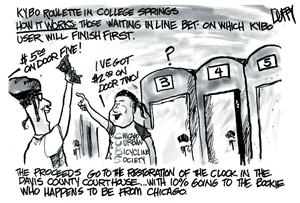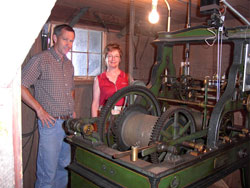DCCPF History
The DCCPF Story: Events leading up to and including the formation of the Fund.
This is a history of events leading to formation of the Davis County Courthouse Preservation Fund, a not-for-profit corporation whose mission is to augment the County Board of Supervisor’s Budget with private funding of projects designed to preserve, enhance and protect the historical legacy and visual integrity of the Davis County, Iowa Courthouse building and grounds.
The initial meeting on November 28, 2005 was held to choose a Board of Directors representative of all areas of Davis County. Thereafter, Articles of incorporation were registered with the State of Iowa, and by-laws were adopted.
Riding for the Courthouse Clock
 |
|
Donations started coming in 2003 to repair and restore the historic courthouse tower clock and bell. Prior to 2003, the clock was stopped and bell silenced for some time due to fears of damaging the clock mechanism, the bell, or the building structure, then approaching 130 years of age. At about the same time, the people in neighboring Appanoose County decided to restore their courthouse clock. Their clock repair expert, Mr. Rory DeMesy, was invited to view and give an opinion on the Davis County Clock. His visit was covered in a feature article in the local newspaper, the Bloomfield Democrat, and brought to light:
- The historic significance of this particular clock,
- Nearly all of the original parts needed to restore the clock are present in the clock room, and
- Although the clock was not running, it was not broken.
The article piqued the interest of Davis County native Linda Boatman. When the 2003 RAGBRAI (Register's Annual Great Bicycle Ride Across Iowa, sponsored by the Des Moines Register) route included an overnight stay in Bloomfield, Linda sought and received permission to solicit money in the form of cycling mileage pledges for the purpose of restoring the Bloomfield clock. Many gave generously, and the ride campaign raised $4,000. By 2005, the money had grown to $6,000 and she started to think about how to fix the clock.
The first order of business was to determine if the building structure was sound, especially in light of the fears that lead to the stopping of the clock and bell.
A visit with the County Board of Supervisors
 |
|
Rotten floor in the area outside the clockroom, summer, 2005. Photo by Harold Leifer |
A copy of the l997 Architectural Report was obtained and Boatman was invited to meet with the supervisors for a tour of the belfry and clock tower. Nine years had passed since the Report was completed. Significant progress had been made fixing some things; other items that had been recommended for immediate attention were not yet completed. The supervisors were asked to include money in their 2007 budget to update the architectural report; which would bring the building’s historic status into focus again and provide prioritization and guidance for future decisions.
During the Supervisors’ Meeting Boatman learned that the HVAC contractor proposed to install black hose on the outside of the building to eight new heat exchangers. This would seriously impact the visual integrity of the building. Further, the supervisors had not been advised that to hold the hose connections in place, straps would be attached to the sandstone veneer in many places. The supervisors knew that wherever the veneer is penetrated, moisture will infiltrate, leading to deterioration of both the veneer and the underlying structural brick. As a result of this discussion, a way was found to route the connections inside the building to the basement level and bring them out through previously compromised basement window openings.
The tour of the belfry and clock tower emphasized the importance of the clock and the bell. In 2003, the clock was restarted by long-time custodian Russell Lundstrom, who over the years has become the most knowledgeable person taking care of this antique mechanism. The clock’s condition after all these years is a tribute to the people of the county who valued it enough to keep it ticking in the best way they knew.
 |
|
Boatman and Lundstrom in the clock room with the clock in the foreground. Photo by Harold Leifer |
However, the trip up through the belfry to the clock room underscored the advanced age of the building: There are many places with precarious footing, where wood is thin and rotted.
Boatman was convinced more than ever that the people of Davis County should form a group dedicated to stewardship of the courthouse building, so that it could better contribute to the continuing and future prosperity of the county.
Concerned citizens of Davis County joined together with Boatman to create the Fund.
